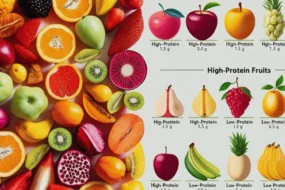
Moong dal, also called Vigna radiata, is a small green bean from the legume family, cultivated in ancient times across India, China, and Southeast Asia. This sweet, fresh ingredient contains protein, amino acids, antioxidants, and vital nutrients.
A staple in Indian dishes, it’s believed to aid in managing blood pressure, lowering LDL cholesterol, and reducing the risk of heart disease, offering numerous health benefits.
Its versatile nature makes it a crucial part of salads, soups, and stir-fries, whether sprouts or dried beans, and it’s now widespread in the US and easily purchased in health food stores.
Moong Dal Benefits
Moong dal is packed with protein, fiber, and antioxidants, supporting heart health, aiding in weight loss, improving digestion, and promoting glowing skin.
Packed With Healthy Nutrients
Mung beans are an excellent source of vitamins, minerals, and plant-based protein, making them a powerhouse of nutrition. One cup (about 7 ounces or 202 grams) of boiled mung beans contains around 212 calories, 0.8 grams of fat,14.2 grams of protein, and 38.7 grams of carbs.
They’re also rich in fiber (15.4 grams) and critical nutrients like folate (B9), providing 80% of the reference daily intake (RDI), as well as manganese (30%), magnesium (24%), vitamin B1 (22%), phosphorus (20%), iron (16%), copper (16%), potassium (15%), and zinc (11%). Additionally, they offer a mix of vitamins B2, B3, B5, B6, and selenium.
Rich in essential amino acids like phenylalanine, leucine, isoleucine, valine, lysine, and arginine, these sprouted beans also deliver more free amino acids and antioxidants while reducing phytic acid. Their unique nutritional composition makes them perfect for a healthy diet.
High Antioxidant May Reduce Chronic Disease Risk
Mung beans are packed with healthy antioxidants like phenolic acids, flavonoids, caffeic acid, and cinnamic acid, which help neutralize harmful molecules known as free radicals.
When present in high amounts, free radicals can interact with cellular components and cause havoc, leading to damage linked to chronic inflammation, heart disease, cancers, and other diseases.
Studies in labs, like test-tube studies, show that mung bean antioxidants can neutralize free radical damage, slowing cancer growth in lung and stomach cells. Sprouted mung beans have more impressive antioxidant profile, offering up to six times more antioxidants than regular mung beans.
While these findings highlight their disease-fighting potential, more human-based research is still needed to make clear recommendations.
Moong Dal Helps with Weight Loss
A 100-gram serving of moong dal has just 347 calories, making it a perfect addition to a weight-loss diet. Its high fiber content aids in preventing constipation and reducing bloating, while the low glycemic index helps in stabilizing blood sugar levels, keeping hunger pangs and sugar cravings under control.
The protein content supports building muscle mass and burning fat, which is essential for healthy weight management.
Additionally, it’s an excellent source of folate, which aids in fat metabolism, further boosting its weight-loss benefits. These features make moong dal as beneficial for adults as the Benefits of Ashwagandha for Kids are for their overall health.
Moong Dal is Good for Heart Health
Eating moong dal regularly is a decisive step for a healthier heart. Packed with magnesium and potassium, moong dal can help maintain steady blood pressure, which is essential for cardiovascular wellness.
Its high fiber content adds even more benefits; specifically, the soluble fiber in moong dal can lower cholesterol levels, helping reduce the risk of heart disease over time.
Additionally, moong dal is loaded with antioxidants like flavonoids and phenolic acids. These natural compounds help protect the heart by fighting oxidative stress and soothing inflammation, which is often linked to long-term heart issues.
For those who prefer plant-based nutrition, moong dal also offers valuable protein, a vital part of a balanced, heart-healthy diet. As someone who cares about heart health, I find moong dal an easy and versatile ingredient that adds layers of nutrition to my meals without much effort, making it a regular for these benefits.
Good for Skin and Stronger Hair
Including moong dal in your diet can significantly benefit skin and hair health. Its rich protein content promotes hair growth and effectively reduces hair fall, making hair look fuller and firmer.
Additionally, the presence of vitamin C helps in collagen synthesis, which is essential for maintaining skin elasticity and reducing wrinkles.
Moong dal’s antioxidants also work wonders to prevent acne and clear skin blemishes, giving a natural glow along with vitamins and minerals that enhance skin texture; applying moong dal paste on the scalp can help with dandruff and other scalp problems, nourishing the scalp deeply for improved hair health.

Folate in Mung Beans for a Healthy Pregnancy
For women expecting a baby, moong dal is a valuable source of folate that supports pregnancy and aids in the optimal growth and development of the child.
A single serving—about one cooked cup or 202 grams—provides nearly 80% of the RDI for folate, which is crucial as low folate levels have been associated with a risk of congenital disabilities.
Additionally, moong dal is rich in iron, protein, and fiber, nutrients that are particularly beneficial during pregnancy. While cooked beans and sprouts are safe to consume, pregnant women should avoid raw mung bean sprouts due to the potential presence of bacteria that could lead to an infection.
Incorporate Moong Dal into Your Diet
- Soups and Stews
Ingredients:
- 1 cup moong dal
- 1 onion, chopped
- 2 cloves garlic, minced
- 1 tomato, chopped
- 1 tsp cumin seeds
- 1 tsp coriander powder
- 1 tsp turmeric powder
- 4 cups water
- Salt to taste
- 2 tbsp oil
- Fresh coriander leaves for garnish
Recipe:
Firstly start by washing and soaking the moong dal in water just for 30 minutes. Heat oil in a pot and then add some cumin seeds. Once they start to splutter, add the chopped onions and minced garlic, frying both of them until golden brown.
Then, add a chopped tomato and cook until they soften. Next, add the soaked dal, turmeric powder, salt, coriander powder, and water. Mix well, bring the mixture to a boil, then cover and cook for 20-25 minutes until the dal becomes soft. At the end, garnish with fresh coriander leaves and serve hot for a delicious and nutritious meal.
- Salads
Ingredients:
- Sprouted moong dal
- Cucumber, chopped
- Tomato, chopped
- Olive oil
- Lemon juice
- Salt
- Carrot, grated
- Mint, chopped
- Coriander, chopped
- Honey
- Beetroot, roasted
- Spinach, chopped
- Crumbled feta cheese
- Balsamic vinegar
Recipe:
Adding sprouted moong dal to your salads is a fantastic way to incorporate this legume into your diet. Start with a simple moong dal salad by combining sprouted moong dal with chopped cucumber and tomato.
Dress it with lemon juice, a little bit of olive oil, and a pinch of salt for a refreshing meal. For a light, crunchy salad, combine sprouted moong dal with grated carrot, fresh mint, and coriander, then drizzle with a dressing made from olive oil, lemon juice, and a touch of honey.
Another delicious option is a beetroot and moong dal salad, where you combine roasted beetroot, sprouted moong dal, and crumbled feta cheese and dress it with balsamic vinegar for a colorful, nutrient-packed dish.
These salads are rich in protein, fiber, and nutritional boost, filling and satisfying. Meanwhile, moong dal’s nutty flavor and texture add a unique twist to each bite.
FAQ’s
Q: What Happens if We Eat Moong Dal Daily?
Eating moong dal daily supports long-term health with its antioxidant properties, which come from caffeic acid, flavonoids, phenolic acid, and cinnamic acid. These nutrients in mung beans may help lower the risks of chronic diseases like heart disease, diabetes, and certain cancers.
Q: Does Moong Dal have any Side Effects?
Due to its high fiber and phytic acid content, moong dal may cause digestive issues like bloating or gas for some individuals with chronic inflammation or ulcers in the digestive tract. This can be particularly uncomfortable for immune-compromised people or those sensitive to legumes.
Q: Is Moong Dal Good for Skin?
Yes, moong dal is excellent for the skin. Its antioxidants can help prevent acne and reduce blemishes, while vitamins and minerals improve texture. When applied to the scalp, it can also treat dandruff and other problems, helping to nourish and boost hair health.
Q: Does Moong Help in Weight Loss?
Yes, moong beans are high in antioxidants and nutrients, which can help promote weight loss. They also aid digestive health and may lower bad LDL cholesterol, blood pressure, and sugar levels, contributing to overall well-being.
Conclusion
In conclusion, moong dal is a highly nutritious and versatile legume with numerous health benefits. Its rich content of protein, fiber, antioxidants, and essential vitamins makes it a great addition to any diet, promoting heart health, aiding in weight loss, and supporting healthy skin and hair.
Whether consumed as part of soups, salads, or simply as sprouts, moong dal offers a tasty and easy way to boost overall well-being. With its many health-boosting properties, it’s no wonder that moong dal has been a staple in diets worldwide for centuries.
I’m Ayesha Zahid, a certified Nutritionist and Dietitian with over 3 years of hands-on experience helping individuals and families improve their health through nutrition.




